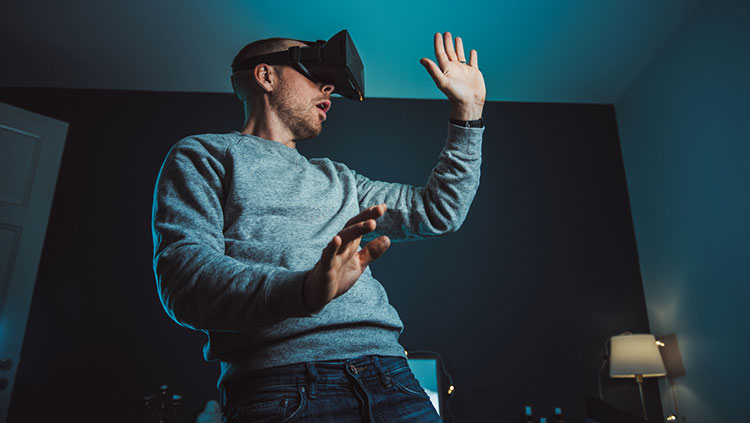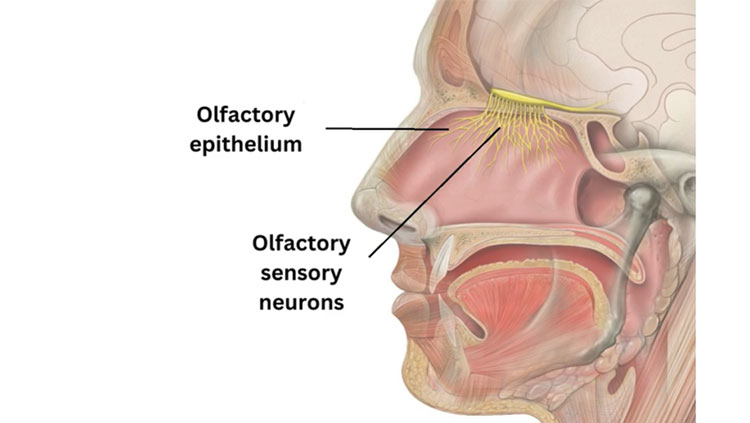Facing Fears — Even Virtually — Could Help People Overcome Their Worst Terrors
- Published5 Mar 2024
- Author Freda Kreier
- Source BrainFacts/SfN

Fear can help people ward off threats to their lives and wellbeing. But fear also can spin out of control and become a disorder. While drugs and therapies help, people who suffer from these disorders tend to have a high rate of relapse back into their fear responses.
Now, new research is hinting at a way to tackle terror using virtual reality. In research presented at Neuroscience 2023 in Washington, D.C., scientists based in Osaka University and Sony Computer Science Laboratories in Tokyo used virtual reality to help participants safely regain a sense of control after facing terrifying situations. In doing so, these studies may help develop more effective ways to treat fear responses.
Testing Virtual Exposure Therapy
When we sense a threat, our bodies respond by either running away, fighting back, or freezing in place. These responses help us survive deadly scenarios. But people with anxiety disorders experience this heightened state even when they’re not under any real threat.
One shape this can take is phobias — an intense fear of a particular thing or situation. Phobias are typically treated by gradually exposing those who suffer from them to their trigger while in a safe environment. In theory, this type of treatment, known as exposure therapy, teaches the brain there isn’t anything to fear from their perceived threat. Eventually, their brains learn the spider in their room, or the crowds in Times Square, are not a threat to their lives.
However, people with phobias must be exposed to their trigger over and over again. “It’s a learning process that is slow and often ineffective,” says Masahiko Haruno, a computational neuroscientist at Osaka University in Japan.
Haruno and his colleagues wanted to see whether virtual reality could speed up the process. To do this, they recruited 59 people with a fear of heights and equipped them with virtual reality headsets. The team also attached sensors to their fingers measuring electrical activity from sweat glands, a marker of sympathetic nervous system activity, to gauge their stress during the experiment.
In the simulation, participants were asked to step out onto a flimsy wooden board above a busy city street. To the people in the simulation, the plank would appear to be hanging out of an opening on the 48th floor of a skyscraper. Nearly all the participants experienced a fear response during this exercise. Some plank walkers were then invited to another simulation where they could fly over the city at a safe height of just five meters for around seven minutes. Other participants watched the flights but did not fly themselves.
Everyone was then invited to repeat the plank simulation. This time, participants who actively flew were significantly less stressed while walking the plank than those who had only watched the flight. And remarkably, people with a fear of heights only needed one flight session to see marked improvement.
“This finding suggests a novel fear extinction mechanism” based on being able to predict safety, Haruno said at the press event.
Key to this process may be a sense of control. In surveys, participants who flew reported feeling more in control than their flightless counterparts. And movement could help anxious people access their power.
Developing Courageous Movements
In another study, researchers wanted to know whether actively moving could help people deal with a stressful situation. At Sony Computer Science Laboratories in Tokyo, researchers used virtual reality headsets to place participants in a simulation of a scary scenario.
Neuroscience experiments generally require people to stay still to avoid background fuzz in electrical readings or brain images. But “this contradicts how humans behave in real life,” said Ai Koizumi, a neuroscientist at Sony Computer Science Laboratories. “When we face something threatening in real life, we move around: we fight or move away.”
Participants wearing VR headsets would walk into a simulated elevator and then get attacked by a stranger who would hit them on the head. The researchers recorded how people physically moved their bodies in response to these attacks. Then, participants were sent back in to face their attacker — this time, with a special spray that could ward off their assailant. The team found people who fought back were less likely to relapse back into a fear response after being confronted by their attacker than those that didn’t.
Whether or not these experiences in virtual reality translate to real life is still unclear. Someone who is deathly afraid of heights might still feel panicky on the 48th floor of a real building, no matter if they flew in a simulation. But both Koizumi and Haruno suspect the lesson learned virtually can translate into the real world, especially as virtual reality has previously helped people with arachnophobia — a fear of spiders.
And regardless, these new findings suggest getting a chance to physically respond to a scary situation could help people deal with lingering trauma. “You[‘ve] got to move your body to conquer your fear,” said Koizumi.
CONTENT PROVIDED BY
BrainFacts/SfN
References
Alemany-González, M., Wokke, M. E., Chiba, T., Narumi, T., Kaneko, N., Yokoyama, H., Watanabe, K., Nakazawa, K., Imamizu, H., Koizumi, A. (2023). Fear in action: Fear conditioning and alleviation through body movements. bioRxiv. https://doi.org/10.1101/2022.06.20.496915
Hinze, J., Röder, A., Menzie, N., Müller, U., Domschke, K., Riemenschneider, M., & Noll-Hussong, M. (2021). Spider Phobia: Neural Networks Informing Diagnosis and (Virtual/Augmented Reality-Based) Cognitive Behavioral Psychotherapy-A Narrative Review. Frontiers in psychiatry, 12, 704174. https://doi.org/10.3389/fpsyt.2021.704174


















